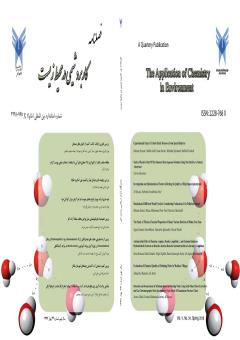Optimization of malachite green cationic dye adsorption process by chitosan-ethyl acrylate polymer biosorbent using Taguchi model
Subject Areas : Chemistry and Chemical Engineering of all specializationsNasim Ziaei far 1 * , Saber Khodaei 2
1 - Assistant Prof. of applied Chemistry, Department of science, branch, Islamic Azad University, Maragheh, Iran.
2 - Department of Statistics, Maragheh branch, Islamic Azad University, Maragheh, Iran.
Keywords: polymeric bioabsorbent, chitosan, malachite green, Taguchi,
Abstract :
Many dyes, such as malachite green, produce toxic by-products due to various reactions, which are harmful to aquatic organisms and humans. Surface absorption technology has wide applications in water and wastewater treatment. In this study, the natural biopolymer chitosan was modified with the organic compound of ethyl acrylate and was used for the surface absorption of malachite green cationic dye. The obtained compound was identified using infrared spectroscopy. To investigate the decolorization characteristics of the synthesized compound, effective factors such as pH, concentration of absorbent, concentration of dye, temperature and the effect of different salts were investigated. The results showed that increasing the pH and amount of adsorbent has a positive effect on the amount of color removal, Taguchi method was used to investigate the effect and determine the optimal conditions of each of these parameters. The results of the experiment design showed the highest parameter, gram of bioabsorbent compared to other parameters and the lowest effect related to temperature in surface absorption.
[1] Royer, B.CN., Lima, EC., Vaghetti, JCP., Simon, NM., Calvete. T., Veses, RC., 2009, Applications of Brazilian-pine fruit shell in natural and carbonized forms as adsorbents to removal of methylene blue from aqueous solutions - kinetic and equilibrium study. Journalof Hazardous Materials;164:1213-22.
[2] Lima, EC.RB., Vaghetti, JCP., Simon, NM., Cunha, BM., Pavan, FA., Benvenutti, EV., 2008, Cataluna-Veses R, Airoldi C. Application of Brazilian pine-fruit shell as a biosorbent to removal of reactive red 194 textile dye from aqueous solution Kinetics and equilibrium study. Journal of Hazardous Materials;155:536-55.
[3] Royer, B.CN., Lima, EC., Macedo, TR., Airoldi, C.A., 2015, useful organofunctionalized layered silicate for textile dye removal. Journal of Hazardous Materials;181:366-74.
[4] Factors, DS.B., 2009, Factors associated with textile pattern dermatitis caused by contact allergy to dyes, finishes, foams, and preservatives. Dermatologic Clinics; 27:309-22.
[5] Lima, ROA.de.BA., Salvadori, DMF., Rech, CM., Oliveira, DP., Umbuzeiro, GA., 2017, Mutagenic and carcinogenic potential of a textile azo dye processing plant effluent that impacts a drinking water source. Mutation Research Genetic Toxicology Environmental Mutagenesis;626:53-60.
[6] Carneiro, PA.UG., Oliveira, DP., Zanoni, MVB., 2010, Assessment of water contamination caused by a mutagenic textile effluent/dyehouse effluent bearing disperse dyes. Journal of Hazardous Materials.;174:694-9
[7] Vijayaraghavan, K.YY., 2008, Biosorption of reactive black 5 from aqueous solution using acid-treated biomass of brown seaweed Laminaria sp. Dyes Pigments.;76:726-32.
[8] Aksu, Z.KG., 2008, Comparison of biosorption properties of different kinds of fungi for the removal of Gryfalan Black RL metalcomplex dye. Bioresource Technology; 99(16):7730-41.
[9] Sarkhosh, M., Atafar, Z., Nazari, Sh., Fakhri, Y., Rezae S., Sheikh Mohamadi,A., Mohseni, SM., Baziar, B., 2016, Removal of malachite green, ahazardous dye using graphene oxide as an adsorbent from aqueous phase. J Chem Pharm Res; 8:624-33.
[10] Ziaeifar, N.KM., Behnajady, M.A., Sohrabi ,M.R., Modirshahla, N., 2015, Optimizing adsorption of Cr(VI) from aqueous solutions by NiO nanoparticles using Taguchi and response surface methods. Water science and technology;72(5):721-9.
[11] Hosni.Marand, M.BA., Anbia, M., 2018, Synthesis of clay nanocomposite modified with chitosan in order to remove acid color from water environment. National Conference of Nanostructures, Science and Nano Engineering; Kashan, Iran: Azad University, Kashan Branch.
[12] Sashiwa, H.YN., Ichinose, Y., Sunamoto, J., Aiba, S., 2003, Chemical Modification of Chitosan, 17, Michael Reaction of Chitosan with Acrylic Acid in Water. Macromol Biosci ; 3:231-3.
[13] Salehi, R.AM., Mahmoodi, NM., Bahrami, H., Khorramfar, S., 2010, Novel biocompatible composite (Chitosan–zinc oxide nanoparticle): Preparation, characterization and dye adsorption properties. Colloids and Surfaces B: Biointerfaces; 80:86-93.
[14] Lazaridis, NK.KG., Vassiliou, AA., Bikiaris, DN., 2007, Chitosan Derivatives as Biosorbents for Basic Dyes. Langmuir; 23:7634-43.
[15] Kyzas, GZ.BD., Lazaridis, NK., 2008, Low-Swelling Chitosan Derivatives as Biosorbents for Basic Dyes. Langmuir; 24:4791-9.
[16] Crini, G.GF., Robert, C., Martel, B., Adam, O., Crini, NM., Giorgi, FD., Badot, PM., 2008, The removal of Basic Blue 3 from aqueous solutions by chitosan-based adsorbent: batch studies. J Hazard Mater; 153:96-106.
[17] Uzun, I., 2006, Kinetics of the adsorption of reactive dyes by chitosan. Dyes Pigments; 70:76-83.

